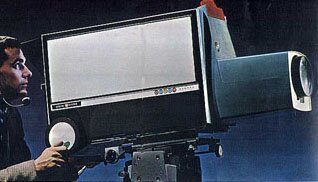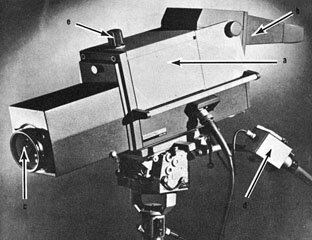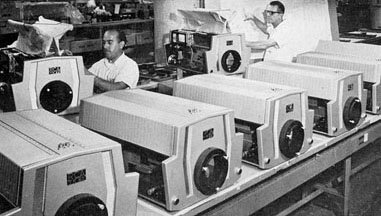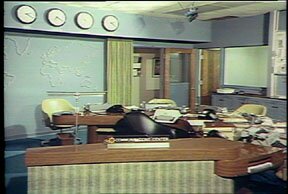|
Black and White to Color |
Channel 13's original owners had stated that color would be part of the picture when they signed on the air in 1955. The station was capable of broadcasting a color signal received from the CBS network, but this only required a rack of colorplexer equipment in master control.**
WFLA had been showing local color from their film chain since February, 1955, but locally produced programs remained in black and white until 1966.
At WTVT, a 16mm color film chain was installed early on but rarely used due to the limited availability of color programming.
An early newspaper advertisement lists a program called "Fishing Fun" with Capt. Marty Foster. In very tiny typeface, the ad states that 'film portion telecast in color.' Color film for the program was provided by Foster, since the station did not have color film processing until 1966.
The cost of live color equipment, CBS' lack of interest in providing regular color programs, and the low percentage of color receivers in the Tampa Bay area prevented WTVT from seriously considering local live and tape color until the mid 60's.
The NBC network had pioneered color programming in the 1950's and slowly added more color shows until announcing that in September of 1966, they would be "The Full Color Network." CBS and ABC apparently saw that color was where the industry was heading and planned to have their prime time schedules mostly color for the fall of 1966. The price of color television receivers had steadily fallen over the years and by 1965, a 21" set could be purchased for under $500 (still a good amount of money, since a middle class family earned in the neighborhood of $150 a week). In 1964, the number of Tampa Bay area viewers with color receivers was around 4%. Two years later, it would be 14%, the 'magic' number that made it logical for Channel 13 to provide local, live color.
Four manufacturers were selling broadcast color television cameras in 1965: RCA, Philips, G.E., and Marconi.
|
|
|
|
|
|
The cameras made by Philips (carrying their Norelco trademark) were selected for use by CBS, and history has proven their superior color picture over all competitors. WTVT's Chief Engineer Bill Witt opted to stay with the familiar, and in the fall of 1965 placed an order for four color cameras from RCA. It is possible that price (around $65,000 per camera), delivery schedules, or a concern over foreign-made equipment and their reliability might have been involved in his decision. Three TK-42s were delegated to the Tampa studios, and one to be used at the St. Pete studio.
Channel 8 also put in an order for the same model RCA cameras, while across Tampa Bay, the new ABC affiliate, WLCY, Channel 10, ordered G.E. color cameras.
In 1966, the race was on for local TV station's conversion to color. Stations across the country were clamoring for delivery of their gear in order to secure 'bragging rights' of being first in their market with local, live color. By December of 1965, RCA was inundated with orders.
"C'mon, Earl...let's get these babies finished and out to WTVT!"
TK-42 assembly line at RCA's Camden, N.J. factory.
Color television cameras are more difficult to make than sausages, and the RCA factory struggled to meet with the demand of 300 cameras in 1966. In a December, 1965 St. Petersburg times article, WTVT officials hopefully predicted that their color cameras would arrive by January, 1966. That date was more than optimistic, and RCA finally shipped four TK-42 color cameras to WTVT in late April. WFLA received theirs a few weeks later.
Engineer Adrian Snow adjusts the RCA-TK 42. Note built-in zoom lens.
The WTVT engineers spent several weeks studying the engineering requirements of the new cameras. The TK-42 was an entirely new design, combining three vidicon tubes (red, blue, and green) with an image orthicon (monochrome channel). Lighter in weight and more transistorized than its TK-41 predecessor, the new TK-42 came with a built in 10 to 1 zoom lens.
Inside a TK-42...3 color vidicons and 1 monochrome image orthicon.
Note rear zoom control (left handle) and focus control (right handle)
An odd design choice was made by RCA for the zoom and focus controls. Monochrome turret lens cameras had a single handle to allow the operator to 'rack' to different lenses. RCA engineers carried this motif onto the TK-42 by making the zoom and focus controls appear as dual handles built into the rear of the camera. It was a decision that would later be uniformly rejected by the users of the TK-42.
The camera would fit onto the standard Houston Fearless electric pedestals, but a new, larger control ring was needed for steering. The TK-42 required almost twice as much light as the older black and white models. 250 foot candles was the norm, and in some situations, even more lighting was required.
13 also ordered color film chains and color video tape recording equipment, to make the conversion to color complete.
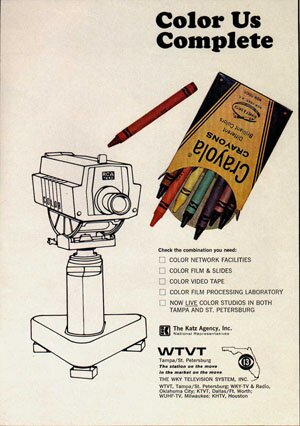
Trade ad featuring the TK-42
Fearing that rival station WFLA would be the first on-air with local live color, the unofficial debut of Channel 13's color telecast occurred on April 30th during a Saturday 6p.m. Pulse newscast. Engineers hastily placed a TK-42 on a wooden crate aimed at anchorman Hugh Smith, who was the only talent to appear in color that evening.
The official debut was made on Monday, June 6th, during the 6p.m. Pulse News, which started in monochrome as Smith announced that color was only a few minutes away. First, color film was introduced by a ceremony recorded at the WTVT film lab. Gene Dodson, the station's general manager, was shown on black and white film as he reached for a switch marked 'color.' At the moment the switch was pushed, the scene changed from monochrome to color...and a new television era began. Back in the studio, Hugh Smith appeared in color and introduced a special message from Ray Dantzler.
Dantzler's topic was the history of color television, and how proud WTVT was to be the first bay area station with it. Unfortunately, Dantzler's speech had been pre-recorded on one of the new color VTRs, and the playback levels were not adjusted properly. Dantzler's skin tone appeared in different bands of color, due to the mis-adjustment of the four heads of the playback machine. It was a minor fault, but pretty unsettling considering that the subject was color television. All was forgiven as the station plunged ahead with color programming.
The newsroom had been freshly painted and new furniture installed. A clear plastic outline of the world's continents covered a light blue wall. The entire set was dubbed "The Color Communications Center."
Back in 1958, a window had been installed in Studio B that allowed a camera to see into the newsroom. A TV-screen shaped frame was placed over the window to provide a dramatic new open for Pulse News by showing a TK-42 as it positioned for a shot of Hugh Smith. As the announcer started his opening copy ("From WTVT's Color Communications Center...This is Pulse...the heartbeat of a changing world"), the cameraman would adjust his zoom lens for a 'push in' to Smith.
Color Communications Center (1966)
Viewers could now enjoy news, sports, and weather in color, in addition to Ernie Lee, Sandy Miller, "Shock" Armstrong, and syndicated programs. For the first time, "The Adventures of Superman," the classic 1950s series starring George Reeves, was telecast in color.***
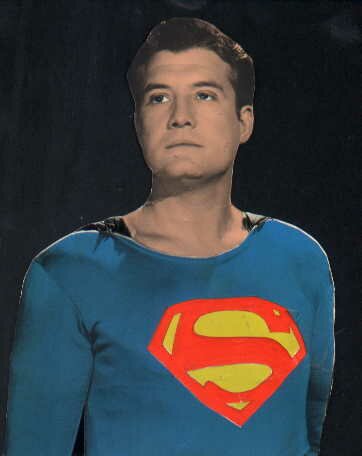
Superman was one of the first syndicated shows telecast in color
over WTVT. This hand-tinted still of George Reeves came from the archives of the Ch. 13 art department.
13 even had their own version of the NBC peacock: an animated fireworks display was shown prior to any syndicated color program or movie.
Shortly after guiding Channel 13 into the color age, Chief Engineer Bill Witt was summoned by Gaylord to help makeover their latest purchase, WUHF-TV in Milwaukee. Lawton Metcalfe was promoted to Chief Engineer, and Adrian Snow was appointed Maintenance Supervisor.
**In 1966, Channel 13 was owned by Gaylord Broadcasting, a unit of the Oklahoma Publishing Company. The flagship station of Opubco was WKY, an independent (and later NBC affiliate) in Oklahoma City. WKY had introduced local live color back in April, 1954! (Source: RCA Broadcast News, Dec. 1954)
***The Superman producers were prescient in filming their shows in color beginning with the 1955 season. Other series that originally aired in black and white but had color prints available were Science Fiction Theater, The Cisco Kid, The Lone Ranger, and Travel/Adventure Theater. All Hanna Barbera cartoons, beginning with Ruff n' Reddy in 1957, were filmed in color, as werethe Popeye cartoons from the 1961 batch. A fair amount of the original Popeyes produced by the Fleischer Brothers and Famous Studios were made in color and included in the package. Stingray, a new series from the producers of Supercar, premiered in color on WTVT as well. Syndicated talk shows such as The Merv Griffin Show also went color in '66.
